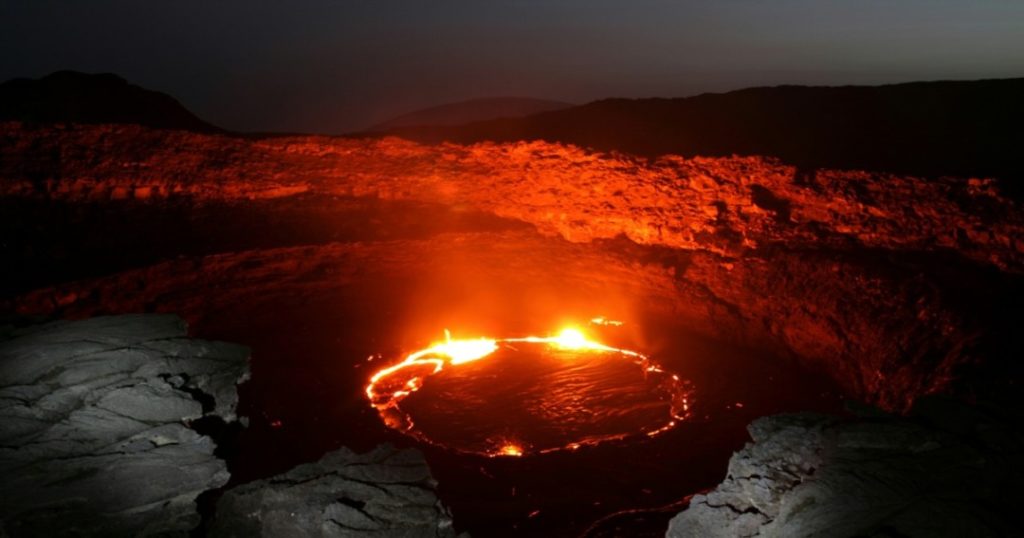
New Delhi — Air travel across the National Capital Region was disrupted on Tuesday after volcanic ash drifting from Ethiopia entered northern India’s upper airspace, forcing multiple flights to be cancelled and prompting aviation authorities to issue safety warnings.
The ash cloud originated from a major eruption of Ethiopia’s Hayli Gubbi volcano, which began spewing thick columns of ash and gas earlier this week. Global monitoring systems recorded the plume rising 13–15 km into the atmosphere — high enough to overlap with international cruising altitudes. Satellite images showed the ash initially drifting westward before upper-level winds carried it over the Arabian Peninsula and into Indian air corridors.
Inside the Ethiopian Volcano Eruption
The disruption in India can be traced back to the sudden and powerful eruption of the Hayli Gubbi volcano in Ethiopia’s Afar region — one of the most tectonically active zones on the planet. The region sits on the East African Rift, where the African continent is slowly pulling apart, making it especially prone to frequent earthquakes and volcanic activity. Even by local standards, scientists say this eruption has been among the most intense in recent years.
How the Eruption Unfolded
The event began after a rapid build-up of pressure beneath the volcano, caused by rising magma interacting with underground water and older lava layers. The sudden release triggered an explosive column of ash and gas that shot 13–15 km into the sky — roughly the altitude at which most commercial jets fly.
Why This Eruption Is Different
While many eruptions in the region produce ash clouds that remain relatively localised, this one generated extremely fine, dry volcanic ash capable of staying suspended over long distances. The force of the eruption pushed the ash high enough to enter fast-moving stratospheric winds, enabling it to travel across multiple countries before reaching India.
Volcanologists also highlighted the ash’s composition — rich in silica — which makes it particularly hazardous to aircraft. This type of ash can:
- Melt inside jet engines
- Scratch or cloud cockpit windows
- Disrupt aircraft sensors
- Causes engine failure if ingested in large quantities
Fortunately, because the volcano is surrounded by sparse settlements, damage on the ground in Ethiopia has been minimal. But its atmospheric impact has been far more far-reaching.
How Long Will the Ash Travel?
Depending on wind patterns, such ash plumes can remain aloft for several days or even weeks. In this case, upper-level winds swept the cloud rapidly from East Africa across Yemen, Oman, the Arabian Sea, and eventually northern India. Forecast models suggest that the densest part of the plume should start thinning within 24–36 hours.
Volcanic Ash Advisory Centres (VAAC) in Toulouse, along with global satellite networks, have been tracking the plume’s movement. Their alerts helped Indian authorities prepare in advance as the ash approached busy flight routes.
Impact on India’s Aviation Network
Once the ash drifted into Delhi’s upper airspace late Monday, airlines moved quickly. Several carriers — including Air India, Akasa Air, and multiple international operators — cancelled or diverted flights. Air India also grounded a few aircraft for precautionary engine checks to rule out any exposure to ash on earlier routes.
The Directorate General of Civil Aviation (DGCA) issued a detailed advisory, asking airlines to reroute aircraft, factor in additional fuel for longer paths, and brief cockpit crews on volcanic-ash protocols. Airports were instructed to monitor runways and aprons for ash deposits, though none had been observed by Tuesday afternoon.
Meteorologists expect the disruption to be temporary, saying the ash is concentrated mainly at higher altitudes and should disperse gradually as wind patterns shift. Until then, passengers have been urged to check flight updates frequently, with more delays possible through the day.


